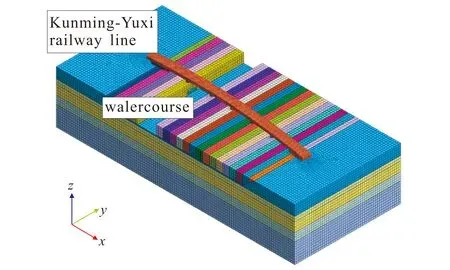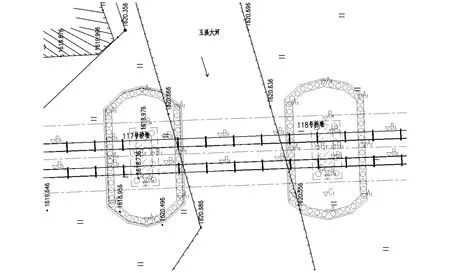Prediction of Vertical Displacement of Bridge Excavation Based on Neural Network*
LI Jiawen,WANG Chongxu,WANG Hao
(School of Civil Engineering,North China University of Technology,Beijing 100144,China)
Abstract:Based on BP neural network method,the vertical deformation prediction of excavation under the bridge is studied.Firstly,the parameter sensitivity of different soil layers is studied and analyzed.It is concluded that the vertical displacement is only sensitive to the parameter change of the first layer of soil.And then,the control parameters of the neural network are determined as cohesion,internal friction angle,elastic modulus,Poisson's ratio,excavation depth,and excavation length of the first layer of soil.The B-R method is used for iterative calculation Verification of the established network show that the prediction accuracy of the model is high.
Key words:excavation under the bridge;deformation prediction;neural network;sensitivity
1 Introduction
River renovation projects are increasing with the treatment of black and odorous water bodies and the construction of sponge cities[1].As the primary way of traffic crossing obstacles such as rivers and lakes,bridge has long been attached great importance to the bearing capacity and qualitative aspects.With the increase in river reconstruction projects,it is inevitable that river widening excavation will occur under the bridge.Soil excavation is an unloading process in vertical and horizontal directions[2].The excavation of the soil under the bridge will produce displacement in the vertical and horizontal directions,which will cause the deformation of the bridge pile and the pier structure.The rebound at the bottom of the foundation pit will also affect the safety of the up-crossing bridge facilities.In particular,the railway bridge has higher requirements for vertical displacement control.Therefore,ensuring the construction safety of excavation under the bridge becomes the primary issue.The excavation process under the bridge has apparent time and space effects,a complex and fuzzy system.Excavation deformation prediction is essential for ensuring construction safety[3].The commonly used methods in excavation deformation prediction are the analytic method[4],a numerical method[5],and a back-propagation(BP)neural network[6].As a representative of new prediction methods,the neural network prediction model is widely used in various fields.However,there are few research in application of the BP neural network in the prediction of vertical displacement of bridge excavation.Based on the Yuxi River widening and reconstruction project in Yuxi City,Yunnan Province,this study predicts the vertical deformation of the hole under the bridge based on the BP neural network method.
2 Research Method
The structure of the BP neural network is shown in Fig.1,which shows the input layer,output layer,and several hidden layers.Each layer contains many neurons,and weights link the nodes between layers.The training process of the neural network includes forward propagation of input information,backward propagation of error,and adjustment of weights.

Fig.1 BP Neural Network Structure
The basic algorithms for input and output values of neural networks are as follows[7]:
whereIiniis the node input value,uijis the corresponding weight,andIhis the hidden node threshold.The propagation of response is the correction of an error,and the calculation formula of error is as follows:
δi=(ti-Iouti)f′(Iouti),
whereIoutiis the output value,andtiis the expectation.For the correction of weights,
uij(t+1)=uij(t)+αδiIini+β(uij(t)-uij(t-1)).
(1)
In formula(1),the first coefficient of the additional term is the learning rate,and the second coefficient is the momentum term,with values between 0~1.
3 Parametric Analysis
3.1 Influential Parameters of Soil
Zhang[8]and Diao[9]studied the constitutive relationship between foundation pit excavation deformation and soil.It indicates that the Mohr-Coulomb(M-C)model is the most widely used constitutive model at this stage.But when M-C is simulated,the vertical displacement of soil will be enlarged and modified by M-C.The modified M-C model is improved based on the M-C model,which eliminates the instability factor of the hexagon calculation vertex and has a good convergence effect.Based on the soil friction experiment,compression-shear experiment,and triaxial experiment,Coulomb proposed the yield criterion of shear stress:
τ=c+σtanφ,
(2)
wherecis cohesive force,φis internal friction angle,andσis normal stress.
When the full Mohr stress circle of the material stress state is tangent to the above equation,it means that the material is damaged.According to formula(2),it can be seen that the basic influential parameters of molar Coulomb mainly include cohesion and internal friction angle.There are 11 nonlinear parameters in the modified M-C constitutive model,namely,cohesion,internal friction angle,expansion angle,porosity,secant stiffness,tangent stiffness,stress-related power index,unloading elastic modulus,failure rate,lateral pressure coefficient of normally consolidated soil,and reference pressure.It can simulate the hardening and better simulate the rebound phenomenon of excavation unloading.
A river in Yunnan province has a total of 5 750 meters that need to be transformed.There are two bridges affected by river widening,named bridge 1 and bridge 2,respectively.Midas GTS is used to simulate and analyze the affected No.1 bridge to determine the influential parameters.The excavation length under the bridge is 98 m,and the excavation depth is 7 m,with five layers of soil.The soil layer parameters are shown in Table 1.

Table 1 Soil Layer Parameter
According to the description in the Midas-GTS manual,the influence range is suggested to take 3~5 times the depth of the foundation pit.Combined with the relevant railway specifications in Yunnan Province,after careful consideration,the influence range is 50 meters perpendicular to the railway direction and 30 meters along both sides of the bridge.The model size is 80 meters wide,180 meters long,and 30 meters high.The model and grid are shown in Fig.2.

Fig.2 Model and Grid(Screenshots)
3.2 Parameter Sensitivity Analysis
The sensitivity analysis of soil parameters in different soil layers is carried out to simplify the calculation model.Sensitivity analysis is to make each parameter change within the possible range of values and study the influence of these parameters on the whole.The degree of leverage depends on the sensitivity coefficient of the parameters the greater the sensitivity coefficient,the greater the influence on the calculation results[10].By introducing different values,the parameter sensitivity coefficients of different soil layers are calculated according to the formula
wherexis the initial input value of the parameter,xris the parameter input value,f(xr)andf(x)are the corresponding vertical displacement calculation results.After calculation,the sensitivity coefficients of each parameter are as follows:the cohesion sensitivity coefficient of miscellaneous fill is 18%;the sensitivity coefficient of internal friction angle of miscellaneous fill is 11.04%;the elastic modulus sensitivity coefficient of miscellaneous fill is 5.62%;Poisson's ratio sensitivity coefficient of miscellaneous fill is 24.9%;the cohesion sensitivity coefficient of silty clay is 3.96%;the sensitivity coefficient of internal friction angle of silty clay is 0.27%;the elastic modulus sensitivity coefficient of silty clay is 1.24%;the Poisson's ratio sensitivity coefficient of silty clay is 8.79%.The parameter influence coefficient of the soil below is basically between 0% and 1%.
The sensitivity analysis shows that the calculation results are very sensitive to the change of the parameters of the first soil layer,namely the excavation soil layer.Therefore,it is considered that the main soil layer affecting the displacement is the excavation soil layer.The change of soil parameters under the excavation layer has little effect on the results.The model can be simplified,and it is considered that the excavation displacement is only affected by the excavation soil layer.The control factors of the neural network can be established.In summary,it can be confirmed that the analysis parameters of the neural network mainly include four parameters:cohesion,internal friction angle,elastic modulus,and Poisson's ratio,and the main control parameters of river transformation include excavation depth and excavation width.
4 A Neural Network
According to the analysis Section 3,cohesion,internal friction angle,elastic modulus,Poisson's ratio,excavation depth,and excavation length are selected as input data.The maximum vertical displacement of the bridge is set as output data.Matlab establishes a neural network.According to the orthogonal experiment table of 6 factors and five levels,25 groups of data can be used to obtain reliable and satisfactory conclusions.According to the common parameters of the first layer of soil,five horizontal values of six factors are established,as shown in Table 2.The parameter control table is shown in Table 3.

Table 2 Values of Influencing Factors

Table 3 BP Neural Network Training Data
Because Bayesian Regularization has good accuracy when the primary database is small[11],the B-R method is used for calculation.After 1 000 pieces of training(once forward propagation and once backward propagation are called once),the error convergence curve is shown in Fig.3.

Fig.3 Error Convergence Curve
It can be seen from Fig.3 that the error convergence is very stable,and the 999th iteration reaches the minimum.And from the training error less than 1,can be seen that the training can be a more realistic reaction with better training results.
5 Case Verification
The established neural network is used for the verification of Bridge 2.The river widening monitoring points of the No.2 bridge are mainly arranged on both sides of the river.The measuring points at the intersection of the bridge are placed on both sides of the river,the bridge abutment,the bridge deck,shown in Fig.4.The monitoring frequency of soil and bridge is once a day,and the vertical displacement control value of the bridge deck is 10 mm.

Fig.4 Distribution of Measuring Points(Screenshots)
For No.2 bridge,the measuring points are mainly arranged on both sides of the river,the bridge abutment,and the bridge deck.The field monitoring data are shown in Fig.5.Fig.5 shows that the maximum displacement of No.bridge is 2.83 mm.

Fig.5 Maximum Displacement Curve of Bridge Monitored
The corresponding parameters of No.2 bridge are input into the established neural network.The related parameters of the No.2 bridge are shown in Table 4.The maximum displacement prediction result of the neural network pier is 2.73 mm.The maximum vertical displacement error of the established neural network is 3.53%.There are errors in the maximum vertical displacement prediction of the bridge,mainly because the influence of different bridge structures is not considered.By comparison,it can be found that the prediction results of the neural network are very close to the field monitoring results,which fully demonstrates the effectiveness of the modified model.

Table 4 Input Parameters for No. 2 Bridge
6 Conclusion
This study established the BP neural network to predict the maximum vertical displacement of soil and the vertical pier during excavation under the bridge.Through the sensitivity analysis of the parameters of different soil layers,it is found that only the first soil layer,namely the excavation soil layer,is sensitive to the change of parameters.Therefore,only the first layer of soil is considered when establishing the neural network control parameters.
The maximum vertical displacement error of the BP neural network for bridge No.2 is 3.53% by comparing the prediction results of the BP neural network with field monitoring.The maximum vertical displacement prediction error of the bridge is too large because the influence of different bridge structures is not considered.It shows that the prediction accuracy of the BP neural network is relatively high,which can replace the finite element numerical simulation to improve the calculation speed.
This method has some limitations:
(1)Because it is a method of probability fitting,there will be critical limitations.What measures should be taken to study the credibility when the predicted value is close to the critical control value in future research.
(2)Because the requirements of high-speed railway bridges are different from those of ordinary highway bridges,this method does not apply to high-speed railway bridges.
(3)Since this method only take the first layer of soil into consideration,the use of this method when the first layer of soil is not the main soil layer needs to be discussed in future research.
(4)Since the neural network calculation does not take into consideration whether the excavation under the bridge will damage the bridge,it only predicts the theoretical displacement.Therefore,the finite element numerical calculation method is still mainly used for precision engineering,and neural network prediction is used as an auxiliary.The iterative formula needs to be optimized to improve accuracy to ensure the convergence effect and time in the following research.In addition,the prediction model under common bridge structures can be added to improve the accuracy.

